Business Ethics Report: Stakeholder Perspectives and Business Behavior
VerifiedAdded on 2022/12/09
|10
|3089
|88
Report
AI Summary
This report provides a comprehensive analysis of business ethics, focusing on the concept of corporate social responsibility (CSR) and its importance for organizations. It begins with an introduction to business ethics, defining key terms and highlighting the significance of ethical practices in the business world. The report then delves into the Kobe Steel, Mitsubishi Materials, and Japan Corporate Governance Woes case study, evaluating the approaches taken by these companies in light of descriptive theories. Furthermore, the report examines stakeholder perspectives on business behavior, categorizing these perspectives into separation, integrated, and ethical viewpoints. The report highlights the importance of ethical considerations in decision-making and the impact of business actions on various stakeholders. The conclusion summarizes the key findings and emphasizes the need for ethical conduct in business to maintain public confidence and ensure long-term success. The report also includes relevant references for further study.
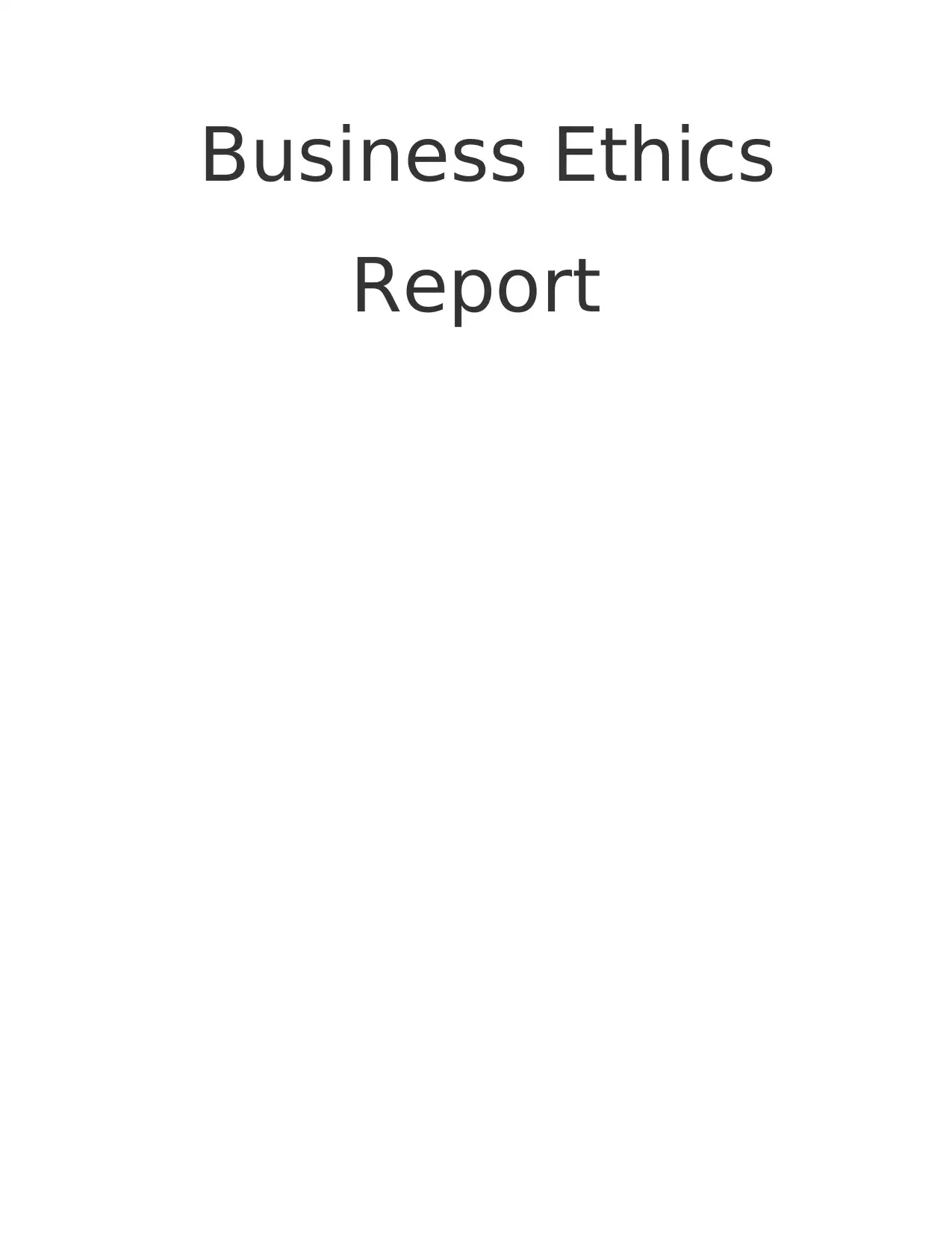
Business Ethics
Report
Report
Paraphrase This Document
Need a fresh take? Get an instant paraphrase of this document with our AI Paraphraser
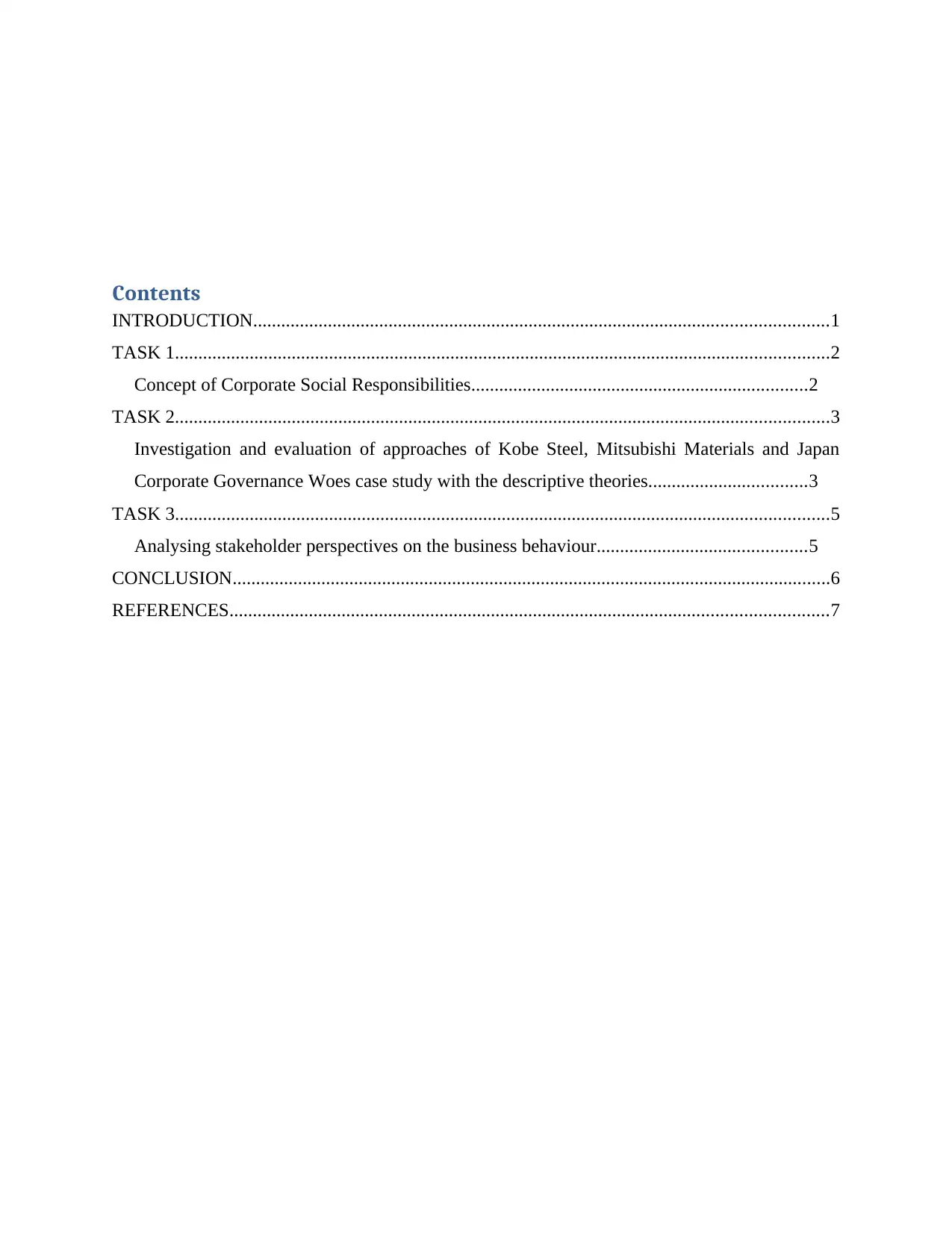
Contents
INTRODUCTION...........................................................................................................................1
TASK 1............................................................................................................................................2
Concept of Corporate Social Responsibilities........................................................................2
TASK 2............................................................................................................................................3
Investigation and evaluation of approaches of Kobe Steel, Mitsubishi Materials and Japan
Corporate Governance Woes case study with the descriptive theories..................................3
TASK 3............................................................................................................................................5
Analysing stakeholder perspectives on the business behaviour.............................................5
CONCLUSION................................................................................................................................6
REFERENCES................................................................................................................................7
INTRODUCTION...........................................................................................................................1
TASK 1............................................................................................................................................2
Concept of Corporate Social Responsibilities........................................................................2
TASK 2............................................................................................................................................3
Investigation and evaluation of approaches of Kobe Steel, Mitsubishi Materials and Japan
Corporate Governance Woes case study with the descriptive theories..................................3
TASK 3............................................................................................................................................5
Analysing stakeholder perspectives on the business behaviour.............................................5
CONCLUSION................................................................................................................................6
REFERENCES................................................................................................................................7
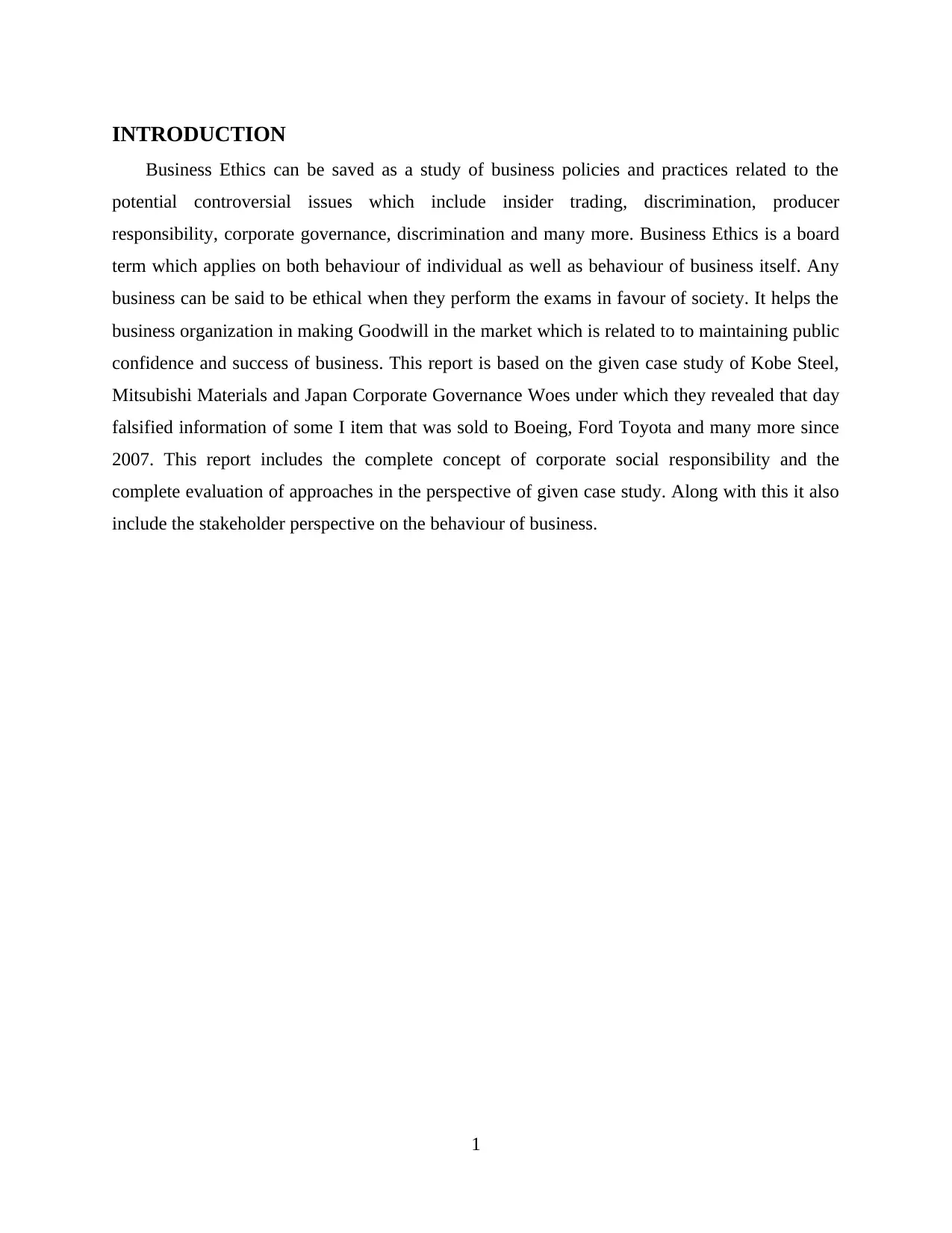
INTRODUCTION
Business Ethics can be saved as a study of business policies and practices related to the
potential controversial issues which include insider trading, discrimination, producer
responsibility, corporate governance, discrimination and many more. Business Ethics is a board
term which applies on both behaviour of individual as well as behaviour of business itself. Any
business can be said to be ethical when they perform the exams in favour of society. It helps the
business organization in making Goodwill in the market which is related to to maintaining public
confidence and success of business. This report is based on the given case study of Kobe Steel,
Mitsubishi Materials and Japan Corporate Governance Woes under which they revealed that day
falsified information of some I item that was sold to Boeing, Ford Toyota and many more since
2007. This report includes the complete concept of corporate social responsibility and the
complete evaluation of approaches in the perspective of given case study. Along with this it also
include the stakeholder perspective on the behaviour of business.
1
Business Ethics can be saved as a study of business policies and practices related to the
potential controversial issues which include insider trading, discrimination, producer
responsibility, corporate governance, discrimination and many more. Business Ethics is a board
term which applies on both behaviour of individual as well as behaviour of business itself. Any
business can be said to be ethical when they perform the exams in favour of society. It helps the
business organization in making Goodwill in the market which is related to to maintaining public
confidence and success of business. This report is based on the given case study of Kobe Steel,
Mitsubishi Materials and Japan Corporate Governance Woes under which they revealed that day
falsified information of some I item that was sold to Boeing, Ford Toyota and many more since
2007. This report includes the complete concept of corporate social responsibility and the
complete evaluation of approaches in the perspective of given case study. Along with this it also
include the stakeholder perspective on the behaviour of business.
1
⊘ This is a preview!⊘
Do you want full access?
Subscribe today to unlock all pages.

Trusted by 1+ million students worldwide
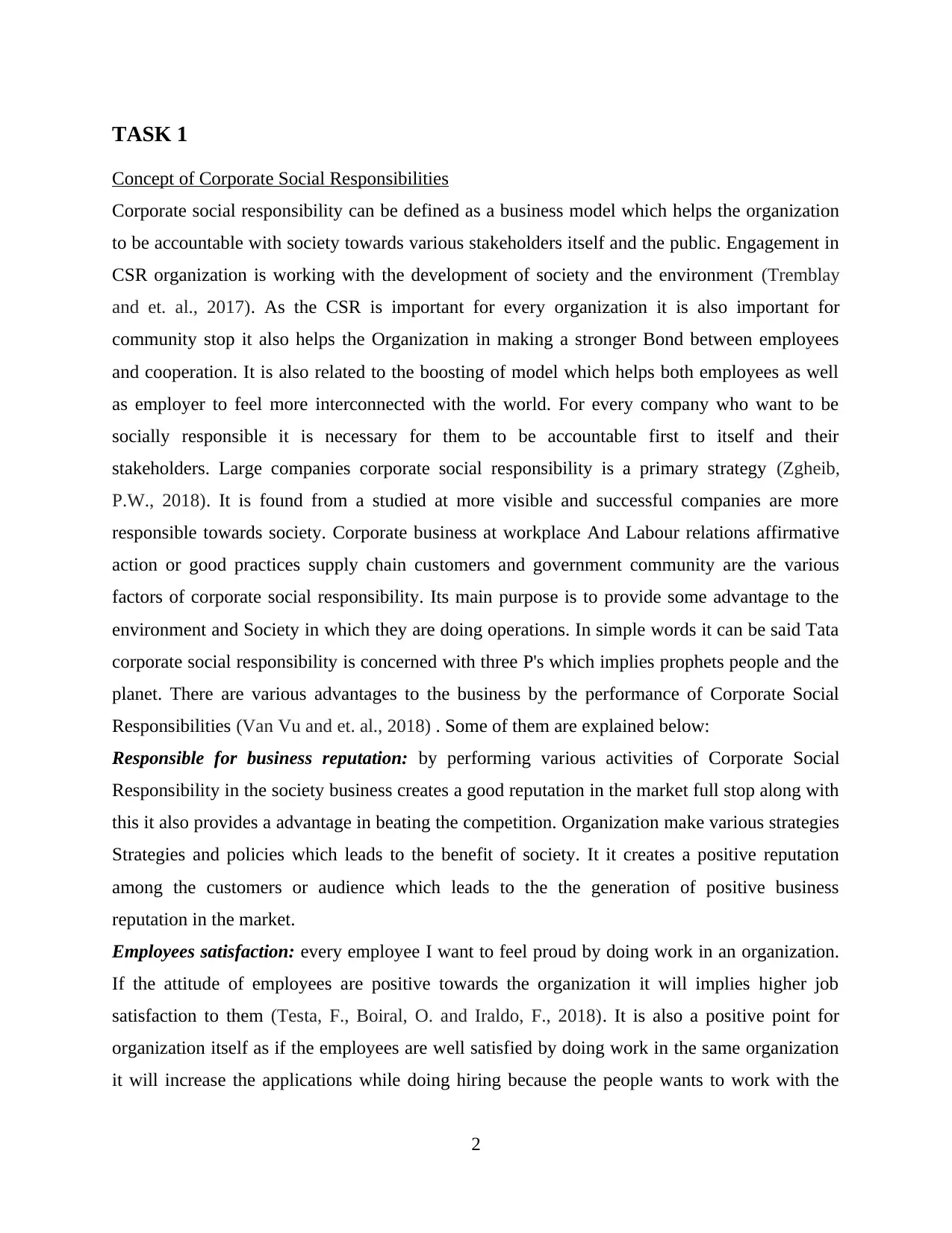
TASK 1
Concept of Corporate Social Responsibilities
Corporate social responsibility can be defined as a business model which helps the organization
to be accountable with society towards various stakeholders itself and the public. Engagement in
CSR organization is working with the development of society and the environment (Tremblay
and et. al., 2017). As the CSR is important for every organization it is also important for
community stop it also helps the Organization in making a stronger Bond between employees
and cooperation. It is also related to the boosting of model which helps both employees as well
as employer to feel more interconnected with the world. For every company who want to be
socially responsible it is necessary for them to be accountable first to itself and their
stakeholders. Large companies corporate social responsibility is a primary strategy (Zgheib,
P.W., 2018). It is found from a studied at more visible and successful companies are more
responsible towards society. Corporate business at workplace And Labour relations affirmative
action or good practices supply chain customers and government community are the various
factors of corporate social responsibility. Its main purpose is to provide some advantage to the
environment and Society in which they are doing operations. In simple words it can be said Tata
corporate social responsibility is concerned with three P's which implies prophets people and the
planet. There are various advantages to the business by the performance of Corporate Social
Responsibilities (Van Vu and et. al., 2018) . Some of them are explained below:
Responsible for business reputation: by performing various activities of Corporate Social
Responsibility in the society business creates a good reputation in the market full stop along with
this it also provides a advantage in beating the competition. Organization make various strategies
Strategies and policies which leads to the benefit of society. It it creates a positive reputation
among the customers or audience which leads to the the generation of positive business
reputation in the market.
Employees satisfaction: every employee I want to feel proud by doing work in an organization.
If the attitude of employees are positive towards the organization it will implies higher job
satisfaction to them (Testa, F., Boiral, O. and Iraldo, F., 2018). It is also a positive point for
organization itself as if the employees are well satisfied by doing work in the same organization
it will increase the applications while doing hiring because the people wants to work with the
2
Concept of Corporate Social Responsibilities
Corporate social responsibility can be defined as a business model which helps the organization
to be accountable with society towards various stakeholders itself and the public. Engagement in
CSR organization is working with the development of society and the environment (Tremblay
and et. al., 2017). As the CSR is important for every organization it is also important for
community stop it also helps the Organization in making a stronger Bond between employees
and cooperation. It is also related to the boosting of model which helps both employees as well
as employer to feel more interconnected with the world. For every company who want to be
socially responsible it is necessary for them to be accountable first to itself and their
stakeholders. Large companies corporate social responsibility is a primary strategy (Zgheib,
P.W., 2018). It is found from a studied at more visible and successful companies are more
responsible towards society. Corporate business at workplace And Labour relations affirmative
action or good practices supply chain customers and government community are the various
factors of corporate social responsibility. Its main purpose is to provide some advantage to the
environment and Society in which they are doing operations. In simple words it can be said Tata
corporate social responsibility is concerned with three P's which implies prophets people and the
planet. There are various advantages to the business by the performance of Corporate Social
Responsibilities (Van Vu and et. al., 2018) . Some of them are explained below:
Responsible for business reputation: by performing various activities of Corporate Social
Responsibility in the society business creates a good reputation in the market full stop along with
this it also provides a advantage in beating the competition. Organization make various strategies
Strategies and policies which leads to the benefit of society. It it creates a positive reputation
among the customers or audience which leads to the the generation of positive business
reputation in the market.
Employees satisfaction: every employee I want to feel proud by doing work in an organization.
If the attitude of employees are positive towards the organization it will implies higher job
satisfaction to them (Testa, F., Boiral, O. and Iraldo, F., 2018). It is also a positive point for
organization itself as if the employees are well satisfied by doing work in the same organization
it will increase the applications while doing hiring because the people wants to work with the
2
Paraphrase This Document
Need a fresh take? Get an instant paraphrase of this document with our AI Paraphraser
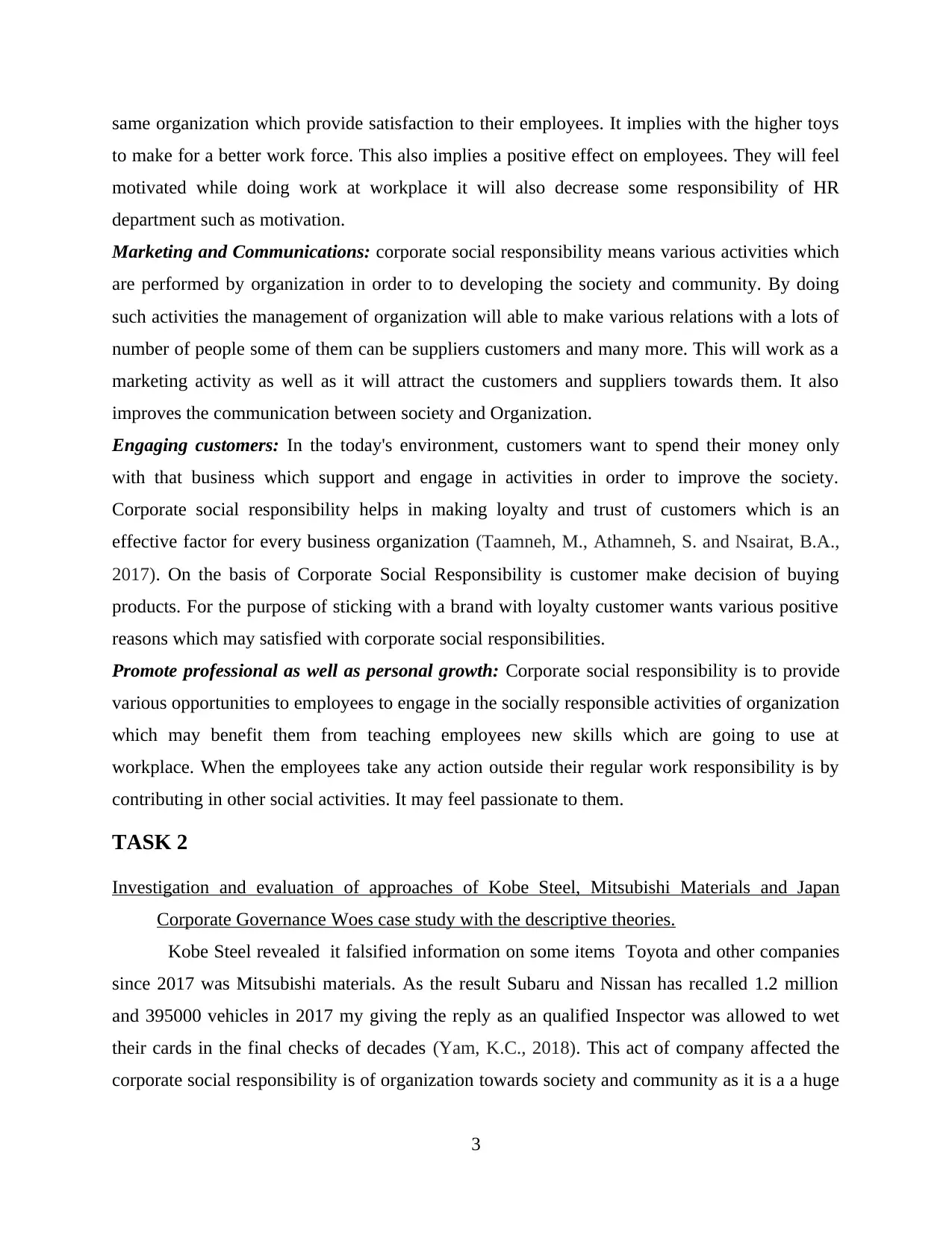
same organization which provide satisfaction to their employees. It implies with the higher toys
to make for a better work force. This also implies a positive effect on employees. They will feel
motivated while doing work at workplace it will also decrease some responsibility of HR
department such as motivation.
Marketing and Communications: corporate social responsibility means various activities which
are performed by organization in order to to developing the society and community. By doing
such activities the management of organization will able to make various relations with a lots of
number of people some of them can be suppliers customers and many more. This will work as a
marketing activity as well as it will attract the customers and suppliers towards them. It also
improves the communication between society and Organization.
Engaging customers: In the today's environment, customers want to spend their money only
with that business which support and engage in activities in order to improve the society.
Corporate social responsibility helps in making loyalty and trust of customers which is an
effective factor for every business organization (Taamneh, M., Athamneh, S. and Nsairat, B.A.,
2017). On the basis of Corporate Social Responsibility is customer make decision of buying
products. For the purpose of sticking with a brand with loyalty customer wants various positive
reasons which may satisfied with corporate social responsibilities.
Promote professional as well as personal growth: Corporate social responsibility is to provide
various opportunities to employees to engage in the socially responsible activities of organization
which may benefit them from teaching employees new skills which are going to use at
workplace. When the employees take any action outside their regular work responsibility is by
contributing in other social activities. It may feel passionate to them.
TASK 2
Investigation and evaluation of approaches of Kobe Steel, Mitsubishi Materials and Japan
Corporate Governance Woes case study with the descriptive theories.
Kobe Steel revealed it falsified information on some items Toyota and other companies
since 2017 was Mitsubishi materials. As the result Subaru and Nissan has recalled 1.2 million
and 395000 vehicles in 2017 my giving the reply as an qualified Inspector was allowed to wet
their cards in the final checks of decades (Yam, K.C., 2018). This act of company affected the
corporate social responsibility is of organization towards society and community as it is a a huge
3
to make for a better work force. This also implies a positive effect on employees. They will feel
motivated while doing work at workplace it will also decrease some responsibility of HR
department such as motivation.
Marketing and Communications: corporate social responsibility means various activities which
are performed by organization in order to to developing the society and community. By doing
such activities the management of organization will able to make various relations with a lots of
number of people some of them can be suppliers customers and many more. This will work as a
marketing activity as well as it will attract the customers and suppliers towards them. It also
improves the communication between society and Organization.
Engaging customers: In the today's environment, customers want to spend their money only
with that business which support and engage in activities in order to improve the society.
Corporate social responsibility helps in making loyalty and trust of customers which is an
effective factor for every business organization (Taamneh, M., Athamneh, S. and Nsairat, B.A.,
2017). On the basis of Corporate Social Responsibility is customer make decision of buying
products. For the purpose of sticking with a brand with loyalty customer wants various positive
reasons which may satisfied with corporate social responsibilities.
Promote professional as well as personal growth: Corporate social responsibility is to provide
various opportunities to employees to engage in the socially responsible activities of organization
which may benefit them from teaching employees new skills which are going to use at
workplace. When the employees take any action outside their regular work responsibility is by
contributing in other social activities. It may feel passionate to them.
TASK 2
Investigation and evaluation of approaches of Kobe Steel, Mitsubishi Materials and Japan
Corporate Governance Woes case study with the descriptive theories.
Kobe Steel revealed it falsified information on some items Toyota and other companies
since 2017 was Mitsubishi materials. As the result Subaru and Nissan has recalled 1.2 million
and 395000 vehicles in 2017 my giving the reply as an qualified Inspector was allowed to wet
their cards in the final checks of decades (Yam, K.C., 2018). This act of company affected the
corporate social responsibility is of organization towards society and community as it is a a huge
3
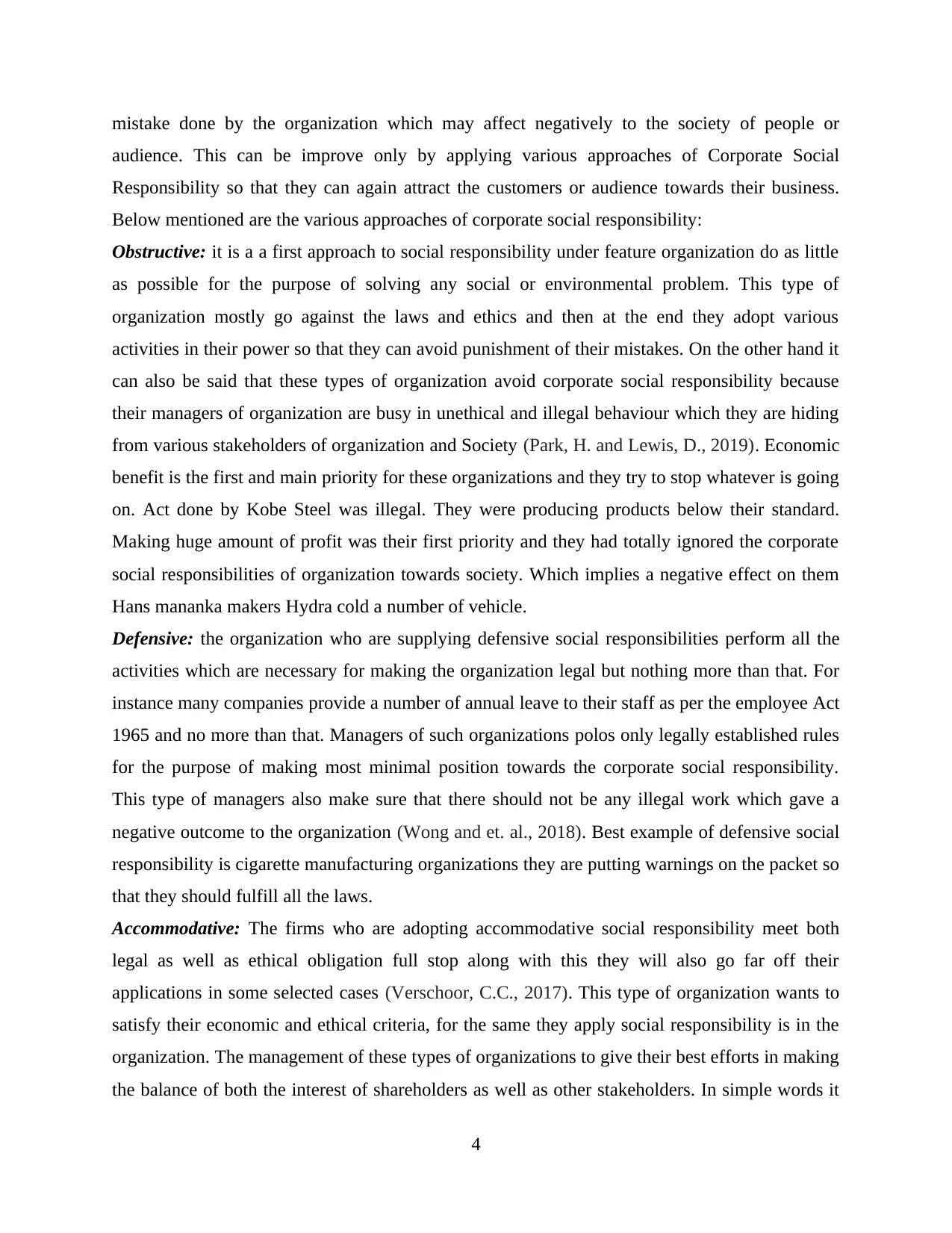
mistake done by the organization which may affect negatively to the society of people or
audience. This can be improve only by applying various approaches of Corporate Social
Responsibility so that they can again attract the customers or audience towards their business.
Below mentioned are the various approaches of corporate social responsibility:
Obstructive: it is a a first approach to social responsibility under feature organization do as little
as possible for the purpose of solving any social or environmental problem. This type of
organization mostly go against the laws and ethics and then at the end they adopt various
activities in their power so that they can avoid punishment of their mistakes. On the other hand it
can also be said that these types of organization avoid corporate social responsibility because
their managers of organization are busy in unethical and illegal behaviour which they are hiding
from various stakeholders of organization and Society (Park, H. and Lewis, D., 2019). Economic
benefit is the first and main priority for these organizations and they try to stop whatever is going
on. Act done by Kobe Steel was illegal. They were producing products below their standard.
Making huge amount of profit was their first priority and they had totally ignored the corporate
social responsibilities of organization towards society. Which implies a negative effect on them
Hans mananka makers Hydra cold a number of vehicle.
Defensive: the organization who are supplying defensive social responsibilities perform all the
activities which are necessary for making the organization legal but nothing more than that. For
instance many companies provide a number of annual leave to their staff as per the employee Act
1965 and no more than that. Managers of such organizations polos only legally established rules
for the purpose of making most minimal position towards the corporate social responsibility.
This type of managers also make sure that there should not be any illegal work which gave a
negative outcome to the organization (Wong and et. al., 2018). Best example of defensive social
responsibility is cigarette manufacturing organizations they are putting warnings on the packet so
that they should fulfill all the laws.
Accommodative: The firms who are adopting accommodative social responsibility meet both
legal as well as ethical obligation full stop along with this they will also go far off their
applications in some selected cases (Verschoor, C.C., 2017). This type of organization wants to
satisfy their economic and ethical criteria, for the same they apply social responsibility is in the
organization. The management of these types of organizations to give their best efforts in making
the balance of both the interest of shareholders as well as other stakeholders. In simple words it
4
audience. This can be improve only by applying various approaches of Corporate Social
Responsibility so that they can again attract the customers or audience towards their business.
Below mentioned are the various approaches of corporate social responsibility:
Obstructive: it is a a first approach to social responsibility under feature organization do as little
as possible for the purpose of solving any social or environmental problem. This type of
organization mostly go against the laws and ethics and then at the end they adopt various
activities in their power so that they can avoid punishment of their mistakes. On the other hand it
can also be said that these types of organization avoid corporate social responsibility because
their managers of organization are busy in unethical and illegal behaviour which they are hiding
from various stakeholders of organization and Society (Park, H. and Lewis, D., 2019). Economic
benefit is the first and main priority for these organizations and they try to stop whatever is going
on. Act done by Kobe Steel was illegal. They were producing products below their standard.
Making huge amount of profit was their first priority and they had totally ignored the corporate
social responsibilities of organization towards society. Which implies a negative effect on them
Hans mananka makers Hydra cold a number of vehicle.
Defensive: the organization who are supplying defensive social responsibilities perform all the
activities which are necessary for making the organization legal but nothing more than that. For
instance many companies provide a number of annual leave to their staff as per the employee Act
1965 and no more than that. Managers of such organizations polos only legally established rules
for the purpose of making most minimal position towards the corporate social responsibility.
This type of managers also make sure that there should not be any illegal work which gave a
negative outcome to the organization (Wong and et. al., 2018). Best example of defensive social
responsibility is cigarette manufacturing organizations they are putting warnings on the packet so
that they should fulfill all the laws.
Accommodative: The firms who are adopting accommodative social responsibility meet both
legal as well as ethical obligation full stop along with this they will also go far off their
applications in some selected cases (Verschoor, C.C., 2017). This type of organization wants to
satisfy their economic and ethical criteria, for the same they apply social responsibility is in the
organization. The management of these types of organizations to give their best efforts in making
the balance of both the interest of shareholders as well as other stakeholders. In simple words it
4
⊘ This is a preview!⊘
Do you want full access?
Subscribe today to unlock all pages.

Trusted by 1+ million students worldwide
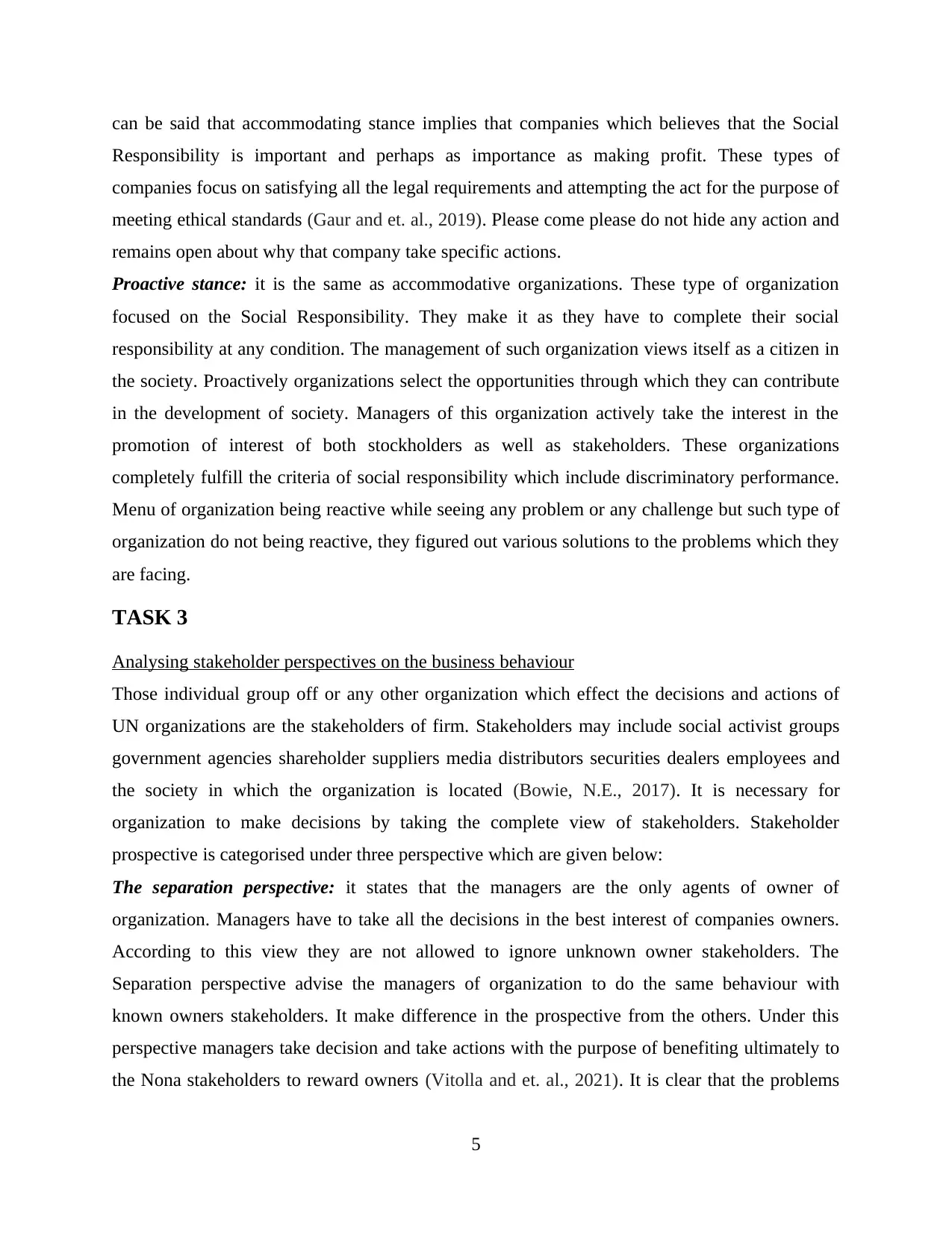
can be said that accommodating stance implies that companies which believes that the Social
Responsibility is important and perhaps as importance as making profit. These types of
companies focus on satisfying all the legal requirements and attempting the act for the purpose of
meeting ethical standards (Gaur and et. al., 2019). Please come please do not hide any action and
remains open about why that company take specific actions.
Proactive stance: it is the same as accommodative organizations. These type of organization
focused on the Social Responsibility. They make it as they have to complete their social
responsibility at any condition. The management of such organization views itself as a citizen in
the society. Proactively organizations select the opportunities through which they can contribute
in the development of society. Managers of this organization actively take the interest in the
promotion of interest of both stockholders as well as stakeholders. These organizations
completely fulfill the criteria of social responsibility which include discriminatory performance.
Menu of organization being reactive while seeing any problem or any challenge but such type of
organization do not being reactive, they figured out various solutions to the problems which they
are facing.
TASK 3
Analysing stakeholder perspectives on the business behaviour
Those individual group off or any other organization which effect the decisions and actions of
UN organizations are the stakeholders of firm. Stakeholders may include social activist groups
government agencies shareholder suppliers media distributors securities dealers employees and
the society in which the organization is located (Bowie, N.E., 2017). It is necessary for
organization to make decisions by taking the complete view of stakeholders. Stakeholder
prospective is categorised under three perspective which are given below:
The separation perspective: it states that the managers are the only agents of owner of
organization. Managers have to take all the decisions in the best interest of companies owners.
According to this view they are not allowed to ignore unknown owner stakeholders. The
Separation perspective advise the managers of organization to do the same behaviour with
known owners stakeholders. It make difference in the prospective from the others. Under this
perspective managers take decision and take actions with the purpose of benefiting ultimately to
the Nona stakeholders to reward owners (Vitolla and et. al., 2021). It is clear that the problems
5
Responsibility is important and perhaps as importance as making profit. These types of
companies focus on satisfying all the legal requirements and attempting the act for the purpose of
meeting ethical standards (Gaur and et. al., 2019). Please come please do not hide any action and
remains open about why that company take specific actions.
Proactive stance: it is the same as accommodative organizations. These type of organization
focused on the Social Responsibility. They make it as they have to complete their social
responsibility at any condition. The management of such organization views itself as a citizen in
the society. Proactively organizations select the opportunities through which they can contribute
in the development of society. Managers of this organization actively take the interest in the
promotion of interest of both stockholders as well as stakeholders. These organizations
completely fulfill the criteria of social responsibility which include discriminatory performance.
Menu of organization being reactive while seeing any problem or any challenge but such type of
organization do not being reactive, they figured out various solutions to the problems which they
are facing.
TASK 3
Analysing stakeholder perspectives on the business behaviour
Those individual group off or any other organization which effect the decisions and actions of
UN organizations are the stakeholders of firm. Stakeholders may include social activist groups
government agencies shareholder suppliers media distributors securities dealers employees and
the society in which the organization is located (Bowie, N.E., 2017). It is necessary for
organization to make decisions by taking the complete view of stakeholders. Stakeholder
prospective is categorised under three perspective which are given below:
The separation perspective: it states that the managers are the only agents of owner of
organization. Managers have to take all the decisions in the best interest of companies owners.
According to this view they are not allowed to ignore unknown owner stakeholders. The
Separation perspective advise the managers of organization to do the same behaviour with
known owners stakeholders. It make difference in the prospective from the others. Under this
perspective managers take decision and take actions with the purpose of benefiting ultimately to
the Nona stakeholders to reward owners (Vitolla and et. al., 2021). It is clear that the problems
5
Paraphrase This Document
Need a fresh take? Get an instant paraphrase of this document with our AI Paraphraser
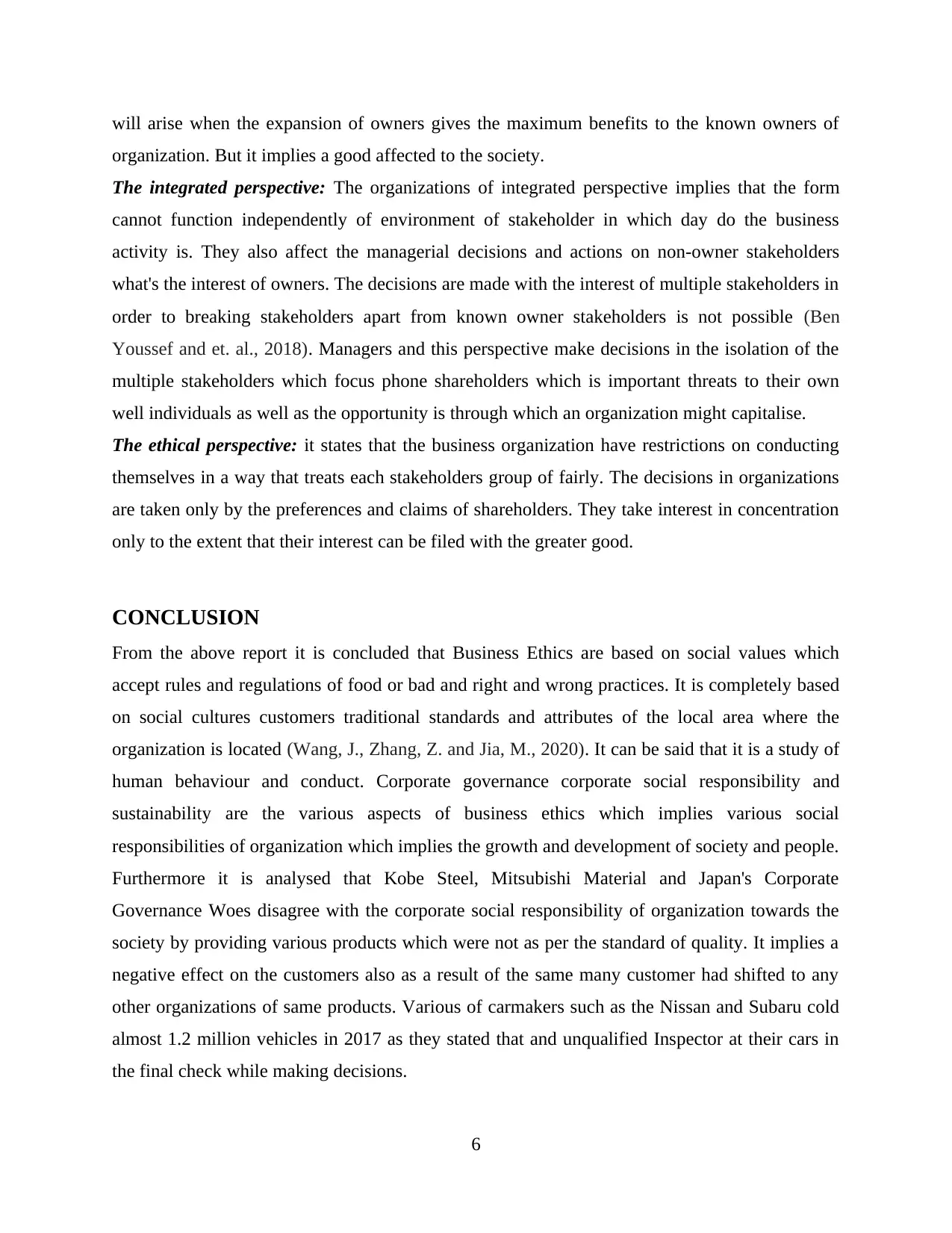
will arise when the expansion of owners gives the maximum benefits to the known owners of
organization. But it implies a good affected to the society.
The integrated perspective: The organizations of integrated perspective implies that the form
cannot function independently of environment of stakeholder in which day do the business
activity is. They also affect the managerial decisions and actions on non-owner stakeholders
what's the interest of owners. The decisions are made with the interest of multiple stakeholders in
order to breaking stakeholders apart from known owner stakeholders is not possible (Ben
Youssef and et. al., 2018). Managers and this perspective make decisions in the isolation of the
multiple stakeholders which focus phone shareholders which is important threats to their own
well individuals as well as the opportunity is through which an organization might capitalise.
The ethical perspective: it states that the business organization have restrictions on conducting
themselves in a way that treats each stakeholders group of fairly. The decisions in organizations
are taken only by the preferences and claims of shareholders. They take interest in concentration
only to the extent that their interest can be filed with the greater good.
CONCLUSION
From the above report it is concluded that Business Ethics are based on social values which
accept rules and regulations of food or bad and right and wrong practices. It is completely based
on social cultures customers traditional standards and attributes of the local area where the
organization is located (Wang, J., Zhang, Z. and Jia, M., 2020). It can be said that it is a study of
human behaviour and conduct. Corporate governance corporate social responsibility and
sustainability are the various aspects of business ethics which implies various social
responsibilities of organization which implies the growth and development of society and people.
Furthermore it is analysed that Kobe Steel, Mitsubishi Material and Japan's Corporate
Governance Woes disagree with the corporate social responsibility of organization towards the
society by providing various products which were not as per the standard of quality. It implies a
negative effect on the customers also as a result of the same many customer had shifted to any
other organizations of same products. Various of carmakers such as the Nissan and Subaru cold
almost 1.2 million vehicles in 2017 as they stated that and unqualified Inspector at their cars in
the final check while making decisions.
6
organization. But it implies a good affected to the society.
The integrated perspective: The organizations of integrated perspective implies that the form
cannot function independently of environment of stakeholder in which day do the business
activity is. They also affect the managerial decisions and actions on non-owner stakeholders
what's the interest of owners. The decisions are made with the interest of multiple stakeholders in
order to breaking stakeholders apart from known owner stakeholders is not possible (Ben
Youssef and et. al., 2018). Managers and this perspective make decisions in the isolation of the
multiple stakeholders which focus phone shareholders which is important threats to their own
well individuals as well as the opportunity is through which an organization might capitalise.
The ethical perspective: it states that the business organization have restrictions on conducting
themselves in a way that treats each stakeholders group of fairly. The decisions in organizations
are taken only by the preferences and claims of shareholders. They take interest in concentration
only to the extent that their interest can be filed with the greater good.
CONCLUSION
From the above report it is concluded that Business Ethics are based on social values which
accept rules and regulations of food or bad and right and wrong practices. It is completely based
on social cultures customers traditional standards and attributes of the local area where the
organization is located (Wang, J., Zhang, Z. and Jia, M., 2020). It can be said that it is a study of
human behaviour and conduct. Corporate governance corporate social responsibility and
sustainability are the various aspects of business ethics which implies various social
responsibilities of organization which implies the growth and development of society and people.
Furthermore it is analysed that Kobe Steel, Mitsubishi Material and Japan's Corporate
Governance Woes disagree with the corporate social responsibility of organization towards the
society by providing various products which were not as per the standard of quality. It implies a
negative effect on the customers also as a result of the same many customer had shifted to any
other organizations of same products. Various of carmakers such as the Nissan and Subaru cold
almost 1.2 million vehicles in 2017 as they stated that and unqualified Inspector at their cars in
the final check while making decisions.
6
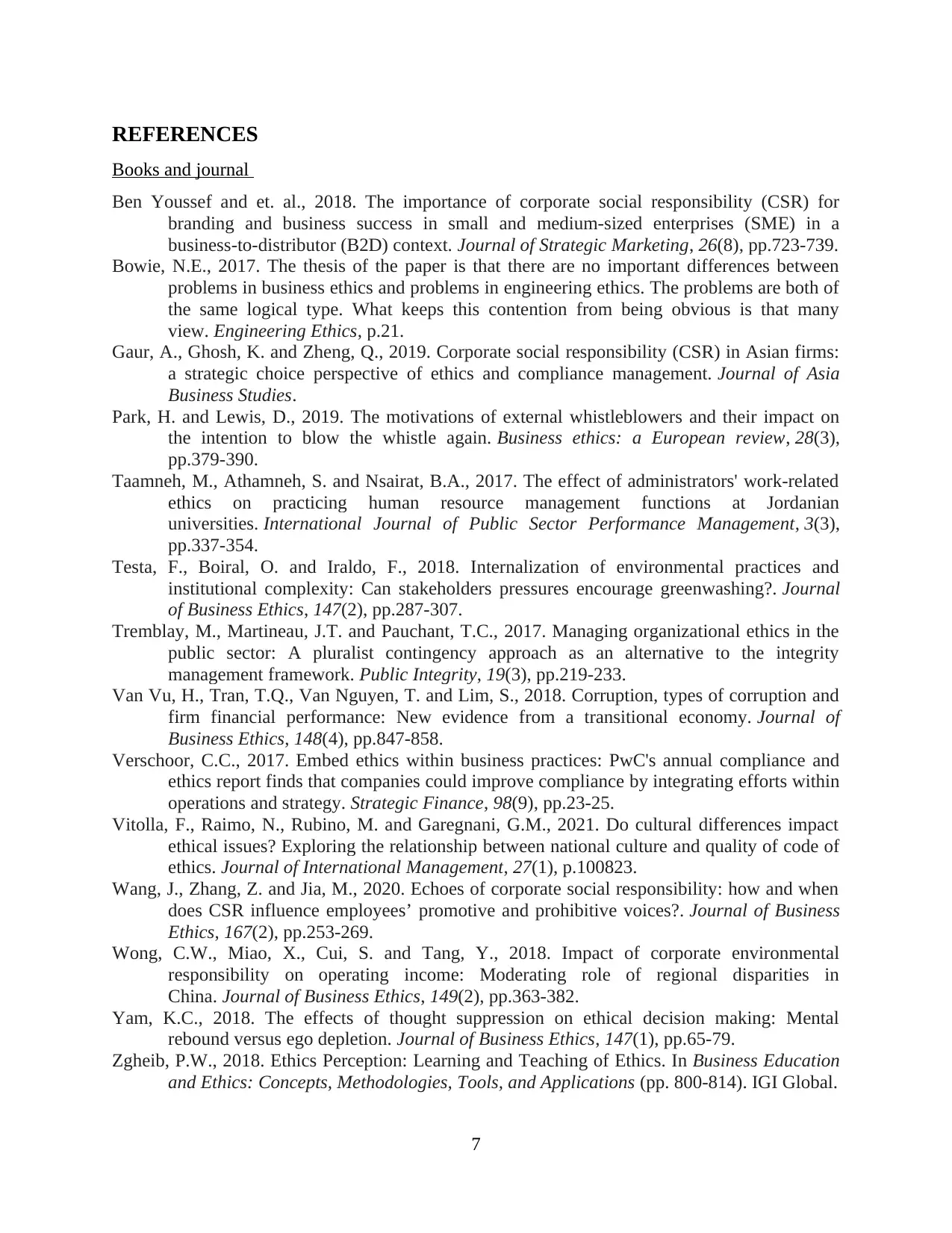
REFERENCES
Books and journal
Ben Youssef and et. al., 2018. The importance of corporate social responsibility (CSR) for
branding and business success in small and medium-sized enterprises (SME) in a
business-to-distributor (B2D) context. Journal of Strategic Marketing, 26(8), pp.723-739.
Bowie, N.E., 2017. The thesis of the paper is that there are no important differences between
problems in business ethics and problems in engineering ethics. The problems are both of
the same logical type. What keeps this contention from being obvious is that many
view. Engineering Ethics, p.21.
Gaur, A., Ghosh, K. and Zheng, Q., 2019. Corporate social responsibility (CSR) in Asian firms:
a strategic choice perspective of ethics and compliance management. Journal of Asia
Business Studies.
Park, H. and Lewis, D., 2019. The motivations of external whistleblowers and their impact on
the intention to blow the whistle again. Business ethics: a European review, 28(3),
pp.379-390.
Taamneh, M., Athamneh, S. and Nsairat, B.A., 2017. The effect of administrators' work-related
ethics on practicing human resource management functions at Jordanian
universities. International Journal of Public Sector Performance Management, 3(3),
pp.337-354.
Testa, F., Boiral, O. and Iraldo, F., 2018. Internalization of environmental practices and
institutional complexity: Can stakeholders pressures encourage greenwashing?. Journal
of Business Ethics, 147(2), pp.287-307.
Tremblay, M., Martineau, J.T. and Pauchant, T.C., 2017. Managing organizational ethics in the
public sector: A pluralist contingency approach as an alternative to the integrity
management framework. Public Integrity, 19(3), pp.219-233.
Van Vu, H., Tran, T.Q., Van Nguyen, T. and Lim, S., 2018. Corruption, types of corruption and
firm financial performance: New evidence from a transitional economy. Journal of
Business Ethics, 148(4), pp.847-858.
Verschoor, C.C., 2017. Embed ethics within business practices: PwC's annual compliance and
ethics report finds that companies could improve compliance by integrating efforts within
operations and strategy. Strategic Finance, 98(9), pp.23-25.
Vitolla, F., Raimo, N., Rubino, M. and Garegnani, G.M., 2021. Do cultural differences impact
ethical issues? Exploring the relationship between national culture and quality of code of
ethics. Journal of International Management, 27(1), p.100823.
Wang, J., Zhang, Z. and Jia, M., 2020. Echoes of corporate social responsibility: how and when
does CSR influence employees’ promotive and prohibitive voices?. Journal of Business
Ethics, 167(2), pp.253-269.
Wong, C.W., Miao, X., Cui, S. and Tang, Y., 2018. Impact of corporate environmental
responsibility on operating income: Moderating role of regional disparities in
China. Journal of Business Ethics, 149(2), pp.363-382.
Yam, K.C., 2018. The effects of thought suppression on ethical decision making: Mental
rebound versus ego depletion. Journal of Business Ethics, 147(1), pp.65-79.
Zgheib, P.W., 2018. Ethics Perception: Learning and Teaching of Ethics. In Business Education
and Ethics: Concepts, Methodologies, Tools, and Applications (pp. 800-814). IGI Global.
7
Books and journal
Ben Youssef and et. al., 2018. The importance of corporate social responsibility (CSR) for
branding and business success in small and medium-sized enterprises (SME) in a
business-to-distributor (B2D) context. Journal of Strategic Marketing, 26(8), pp.723-739.
Bowie, N.E., 2017. The thesis of the paper is that there are no important differences between
problems in business ethics and problems in engineering ethics. The problems are both of
the same logical type. What keeps this contention from being obvious is that many
view. Engineering Ethics, p.21.
Gaur, A., Ghosh, K. and Zheng, Q., 2019. Corporate social responsibility (CSR) in Asian firms:
a strategic choice perspective of ethics and compliance management. Journal of Asia
Business Studies.
Park, H. and Lewis, D., 2019. The motivations of external whistleblowers and their impact on
the intention to blow the whistle again. Business ethics: a European review, 28(3),
pp.379-390.
Taamneh, M., Athamneh, S. and Nsairat, B.A., 2017. The effect of administrators' work-related
ethics on practicing human resource management functions at Jordanian
universities. International Journal of Public Sector Performance Management, 3(3),
pp.337-354.
Testa, F., Boiral, O. and Iraldo, F., 2018. Internalization of environmental practices and
institutional complexity: Can stakeholders pressures encourage greenwashing?. Journal
of Business Ethics, 147(2), pp.287-307.
Tremblay, M., Martineau, J.T. and Pauchant, T.C., 2017. Managing organizational ethics in the
public sector: A pluralist contingency approach as an alternative to the integrity
management framework. Public Integrity, 19(3), pp.219-233.
Van Vu, H., Tran, T.Q., Van Nguyen, T. and Lim, S., 2018. Corruption, types of corruption and
firm financial performance: New evidence from a transitional economy. Journal of
Business Ethics, 148(4), pp.847-858.
Verschoor, C.C., 2017. Embed ethics within business practices: PwC's annual compliance and
ethics report finds that companies could improve compliance by integrating efforts within
operations and strategy. Strategic Finance, 98(9), pp.23-25.
Vitolla, F., Raimo, N., Rubino, M. and Garegnani, G.M., 2021. Do cultural differences impact
ethical issues? Exploring the relationship between national culture and quality of code of
ethics. Journal of International Management, 27(1), p.100823.
Wang, J., Zhang, Z. and Jia, M., 2020. Echoes of corporate social responsibility: how and when
does CSR influence employees’ promotive and prohibitive voices?. Journal of Business
Ethics, 167(2), pp.253-269.
Wong, C.W., Miao, X., Cui, S. and Tang, Y., 2018. Impact of corporate environmental
responsibility on operating income: Moderating role of regional disparities in
China. Journal of Business Ethics, 149(2), pp.363-382.
Yam, K.C., 2018. The effects of thought suppression on ethical decision making: Mental
rebound versus ego depletion. Journal of Business Ethics, 147(1), pp.65-79.
Zgheib, P.W., 2018. Ethics Perception: Learning and Teaching of Ethics. In Business Education
and Ethics: Concepts, Methodologies, Tools, and Applications (pp. 800-814). IGI Global.
7
⊘ This is a preview!⊘
Do you want full access?
Subscribe today to unlock all pages.

Trusted by 1+ million students worldwide

8
1 out of 10
Related Documents
Your All-in-One AI-Powered Toolkit for Academic Success.
+13062052269
info@desklib.com
Available 24*7 on WhatsApp / Email
![[object Object]](/_next/static/media/star-bottom.7253800d.svg)
Unlock your academic potential
Copyright © 2020–2025 A2Z Services. All Rights Reserved. Developed and managed by ZUCOL.




